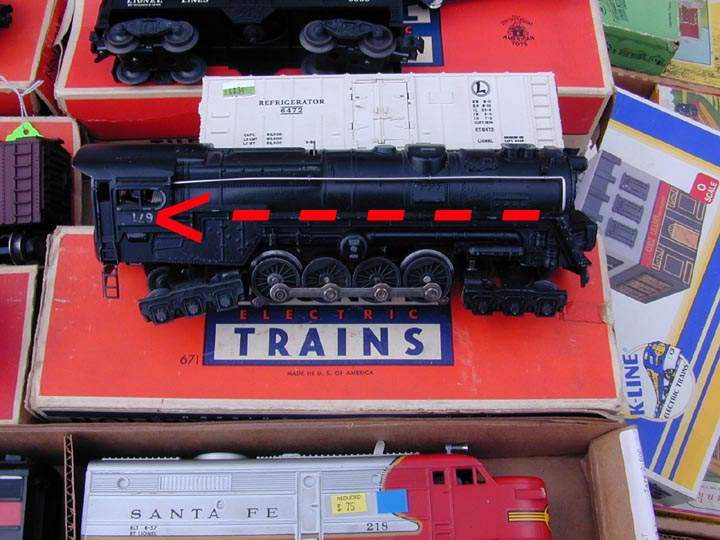Is That Car Really A Variation?
By Jon Bonds
Any collector of toy trains, if he or she collects long enough, will encounter a piece that doesn’t fit the norm. Something is different. Perhaps the piece is represented as a variation, or perhaps no particular claim is made about the piece, but the collector notices something that is different from similar pieces.
How do you know if it is a bona fide variation? Well, sometimes you can never be sure. But education is your best weapon. Learn all you can about the piece. Read collectors’ guides, especially those works about variations, fakes, frauds, and forgeries. Read or view everything you can get your hands on that comes from the TCA Standards Committee, videos, books, pamphlets. Talk to experienced and knowledgeable fellow collectors. If you have a chance to attend any seminars or workshops on variations, fakes, frauds, and forgeries, be there.
I am certainly no expert on these matters. I am still a student of the subject. But I have learned a thing or two during my years of collecting that I will share with you here. It certainly won’t be all you need to know, but especially for the novice, perhaps it will help.
When it comes to variations, there are so many ways that an individual piece can be made to appear different or unique. So I am usually a doubter going in. I want something to support the claim.
Just because a piece has certain parts as you hold it in your hand doesn’t necessarily mean that it came that way from the factory. Trucks can be changed. Boxcar doors can be changed. In fact, the list of parts that can be changed or altered is long.
Sometimes the parts were not changed with the intent to defraud, or to create something bogus. The initial reason may have been an honorable one, such as giving function to couplers. Over time, and after the piece has changed hands multiple times, the modification and its purpose can get lost, and perhaps someone begins to believe, and ultimately to claim, that they have a unique variation.
One should be especially wary of toy train rolling stock with incorrect trucks. It is well-known that throughout the various Lionel® train eras, it has not been uncommon for a car to have its trucks changed, for a variety of reasons.
Cars which were issued with non-operating couplers are especially likely to be altered in this manner. An owner who ran his/her trains might have wanted the car to have operating couplers to increase the play value. So he/she might have taken the car to his/her friendly Lionel® Service Station to have different trucks with operating couplers mounted under the car.
If the change was done by a skilled technician using the proper equipment, it is unlikely that you would be able to tell that the trucks had been changed. An owner with the proper equipment and good skills could even do this himself/herself. Years later, someone mistakenly assumes that the trucks are factory original, and that the car is a variation.
As an extreme example of just how common truck changes are, I have in my possession an American Flyer® #24569 Crane Car. The trucks underneath this car are Lionel® AAR trucks with operating couplers!
So if you run across a car that has trucks on it that are different from the trucks that the car was known to have been released with, be cautious. It is always possible that the car is a rare variation, but it is much more likely that the trucks have been changed.
Color is another area where we need to exercise caution. What appears to be a variation may be nothing more than a color change, be it natural or man-made. If you know that a piece should be a certain color and you find a copy of that item in a different color or with different color lettering, your first objective should be to rule out a color change.
An item (particularly a plastic one) can change color through exposure to certain kinds of light, or by exposing it to chemicals, or even just by natural aging.
Several techniques have been used to produce fraudulent color change. Acids and dyes have both certainly been used to change color. Even a highlighting pen can and has been used to alter the color of lettering on a car.
TCA’s Postwar Lionel Reproduction Handbook Guide by Joe Algozzini details many instances of fraudulent color change. Yes, I know that “Handbook Guide” sounds redundant, but the title is correct as it appears here. This guide, along with the Greenberg Guide series, is highly recommended reading for any collector, novice or experienced. In fact, the TCA guide should probably be characterized as required reading.
So do your homework, learn all that you can about the pieces that you like to collect, and be cautious and a bit skeptical. Many knowledgeable and experienced collectors have been fooled by a bogus piece, so don’t get down on yourself if it happens to you. Keep good notes on your purchases, especially from whom you bought the piece, where, and when. And most importantly, enjoy your trains.






